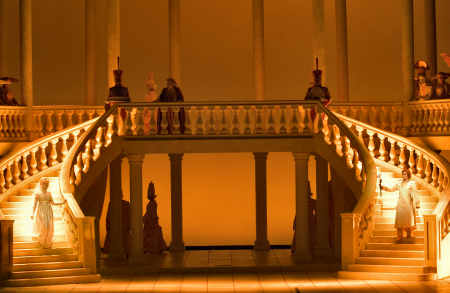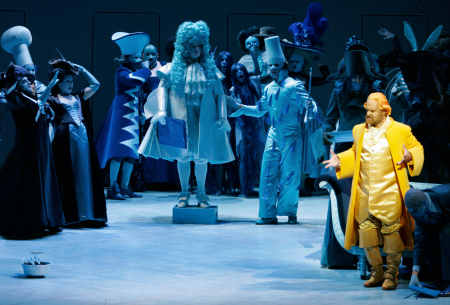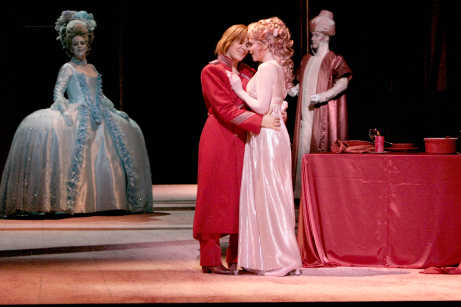Seen and Heard International
Opera Review
Richard Strauss, Der Rosenkavalier:
Soloists, Los Angeles Opera Orchestra, Chorus and Children’s
Chorus/William Vendice, Chorus Master, Kent Nagano, Conductor,
Los Angeles Opera, 1 June 2005 (GS)
Stage Director: Maximilian Schell
Set and Costume Designer: Gottfried Helnwein
Lighting Designer: Alan Burnett
Choreographer: Johann Kresnik

When the curtain rose on Act I, the stage was in near darkness;
most of the light was provided by flickering images from rear
screen projections on the entire back wall of the set from the
film produced of Der Rosenkavalier in 1926. Uh-oh, I
thought, we’re in for an evening of “Hollywood does
Richard Strauss”. These projections, from different films,
also occur at the beginning of each act. My fears were quickly
allayed, however, when the film clips stopped and my attention
was drawn to the two figures rolling around to the composers’
famous “boinking” music on an extra large king size
bed. Let me tell you, there was a lot of schmecken going
on. Once the singing started, I had a very strong feeling that
I was in for a real treat, and as it turned out, I was right.
Canadian soprano Adrianne Pieczonka’s Marschallin was poised,
polished and plush. The famous “monologue” at the
end of Act I, where she laments the passing of time and the fact
that she is going to loose Octavian some day to a younger woman,
was heartfelt and heartrendingly beautiful. British mezzo-soprano
Alice Coote’s Octavian/Mariandel was alternately vocally
virile and voluptuously velvety, especially in the Act II “love
duet” and the third act’s trio. Her “girly”
voice for Mariandel was perfectly plausible and with an excellent
“country” accent too. I overheard someone during the
first intermission say that Ms. Coote was “more butch than
Barbara Stanwyck was in ‘Cattle Queen of Montana.”
Those familiar with her frequent performances in mostly baroque
repertoire (Handel and Gluck) at both Covent Garden and the English
National Opera will be pleased that the stentorian vocal requirements
of this role did not appear to place her voice under any strain.
Elizabeth Futral’s Sophie was a wonder to behold as well
as to hear. Her fearlessness in the face of the forbidding tessitura
of her part made the fireworks even more formidable. For the part
of Baron Ochs, one could not have done better than bass Kurt Rydl.
To the manner born, Mr. Rydl’s Viennese heritage, as well
as his musicianship, made his interpretation more than memorable;
it was quintessential. His facial expressions, his body language,
not to mention those wonderful low notes at the end of Acts I
and II, everything about his performance screamed gemütlich
with and from within the role.

One minor quibble to report. I had been looking forward to the
performance of one of LA Opera’s brightest rising young
stars, tenor Greg Fedderly as the Italian Tenor ever since his
participation was announced at the end of last season. The aria
which is sung by this character comes near the middle of Act I
and is a true focal point of the entire opera. It tells of a heart
that has rejected love and is girded with ice and how it is melted
by love’s arrow. A brief insert in the program informed
me that the performance I attended would feature Garrett Sorenson
in the role. Although adequate, Mr. Sorenson did not cover himself
with glory as I know Mr. Fedderly would have done.
LA Opera is very lucky to have Kent Nagano as
its music director. Considering that he is conducting back-to-back
performances of this opera and Verdi’s Falstaff,
his stamina is also amazing. That notwithstanding, his timing
is impeccable and his musicality monumental. He definitely knows
how to get the very best out of his singers: he supports them
from the pit.
Although he made his LA Opera debut directing the 2001 production
of Wagner’s Lohengrin, the name Maximilian Schell
is not usually associated with the stage direction of operas.
The Oscar winning actor is obviously a renaissance man. He was
truly in his element directing this wonderful “comedy for
music” as the composer described it because the action is
so broad and the characters are in many places so “over
the top”. The wonderful thing about this performance was
the way he integrated the bawdy bits with the funny and clever
bits but never marginalized nor over sentimentalized the romanticism,
which after all, is what it’s all about.
Adding to the overall “rightness” of this production
are two other Austrians, scenery and costume designer Gottfried
Helnwein and choreographer Johann Kresnik. Mr. Helnwein especially
deserves a great deal of praise for his imaginative and impressively
“modern” but economical set pieces. The von Faninal
Palace set for Act II was an absolutely astounding use of space.
Almost all of the characters entered from the sides of the stage,
at least two stories high. They descended to ground level by use
of a two huge curved staircases which come together at the top.
All around on the second floor is a chest high balustrade and
the entire structure is supported by a series of columns which
go through the second floor and continue upwards from there. The
structure was in white, but lighting designer Alan Burrett bathed
the entire scene in a “daylight” type gel. Because
of the elaborateness of the set for Act II (and the time required
to “build” it and then break it down again), the sets
for Acts I and III were the same, merely a big box, dressed differently.
It is a brilliant concept.

Mr. Helnwein’s costumes might be subtitled
“Gays in Millinery”, at least for everyone except
the principals (Ochs excepted). All of the footmen, orphans, waiters,
retinue, etc were wearing very large either three-cornered hats
or things that made them look like Shiners, or turbans, or in
the case of the doctor sent for to treat the Baron after his “mishap”
with the sword, the Mad Hatter from the Lewis Carroll’s
Tea Party. The Baron was awash in bright yellow satin for the
first act and brilliant scarlet red for Acts II and III. For both,
he had enormous plumes of ostrich like feathers in his matching
cocked hats.
Performances continue Wednesday, Saturday and Thursday, June 8,
11 and 16, respectively all at 7 PM. The last performance is on
Father’s Day, Sunday, June 19 at 2 PM. For more information:
http://www.losangelesopera.com
Gregory W. Stouffer
Pictures by Robert Millard, and Studio Helnwein





